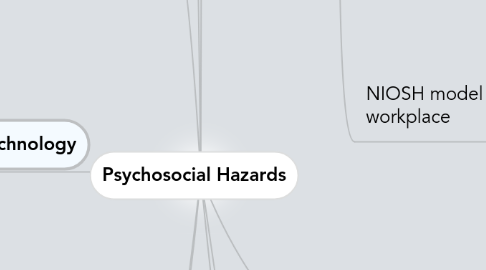
1. PSYCHOSOCIAL MODEL OF HEALTH - Approach to the study of health that highlights the importance of both the social environment & psychological factors
2. Measuring Psychosocial Hazards
2.1. Means to identify psychosocial hazards
2.1.1. Learn to identify stressors
2.1.2. Survey the employees
2.1.3. Look for telltale signs of stress
2.1.4. Be attuned to individual employees
2.2. PREVENTATIVE STRESS MANAGEMENT - An approach to managing stress in the workplace that emphasizes that the health of an organization & its employees are interdependent; encourages the reduction of stressors in the workplace as well as the recognition & management of occupational stress & strain
3. Interventions
3.1. PRIMARY INTERVENTIONS - Stress interventions that involve the reduction or removal of actual stressors
3.2. SECONDARY INTERVENTIONS - Stress intervention techniques that focus on minimizing negative consequences once a person is feeling stress
3.3. TERTIARY INTERVENTIONS - Stress intervention techniques that are used to help those individuals who have not been able to mange workplace stress effectively & who are now experiencing symptoms of strain
4. Spotlight on a Stressor: Injustice at Work
4.1. In organizational justice research, "fairness" is not treated as a one dimensional construct
4.2. Three categories of fairness judgements
4.2.1. 1. DISTRIBUTIVE JUSTICE - The perceived fairness of outcomes
4.2.2. 2. PROCEDURAL JUSTICE - The perceived fairness of decision-making processes
4.2.3. 3. INTERACTIONAL JUSTICE - The perceived fairness of interpersonal treatment
4.2.4. All three associated w/ increased work stress & strain
4.3. Creating a fair workplace
5. Spotlight on a Stressor: Technology
5.1. Increasing role of technology affects the psychological as well as the physical well-being of workers
5.2. Technology-related factors have been implicated as psychosocial stressors
5.2.1. Malfunctions
5.2.2. Isolation
5.2.3. Privacy
5.2.4. Increased jo demands
5.2.5. INcreased expectations for continuous learning
6. Spotlight on a Stressor: Work-Family Conflict
6.1. WORK-FAMILY CONFLICT - A type of inter-role conflict in which the role pressures experienced in the work & family domains are incompatible
6.1.1. WORK-TO-FAMILY CONFLICT - A form of work-family conflict in which work demands interfere w/ the fulfillment of family responsibilities
6.1.2. FAMILY-TO-WORK CONFLICT - A form of work-family conflict in which family demands interfere w/ the fulfillment of work responsibilities
6.2. Causes of work-family conflict
6.3. Outcomes of work-family conflict
7. Stressors
7.1. STRESSOR - An objectively verifiable event that occurs outside the individual that has the potential to cause stress
7.1.1. Four categories
7.1.1.1. Acute
7.1.1.1.1. Specific time onset (ex. you know when it began)
7.1.1.1.2. Specific duration
7.1.1.1.3. Low frequency
7.1.1.1.4. Ex. traffic accident, performance review meeting, conflict
7.1.1.2. Chronic
7.1.1.2.1. No specific time onset
7.1.1.2.2. Short or long duration
7.1.1.2.3. Repeats frequently
7.1.1.2.4. Low or high intensity
7.1.1.2.5. Job inseurity
7.1.1.3. Daily
7.1.1.3.1. Specific onset
7.1.1.3.2. Short duration
7.1.1.3.3. Low in intensity
7.1.1.3.4. Infrequent
7.1.1.3.5. Ex. dealing w/ a broken piece of office equipment
7.1.1.4. Catastrophic
7.1.1.4.1. Specific onset
7.1.1.4.2. Occur infrequently
7.1.1.4.3. High intensity
7.1.1.4.4. Long or short duration
7.1.1.4.5. Distinction b/w acute & catastrophic relates to intensity of stressor
7.1.1.4.6. Direct threat to life, loss of life, or major property damage
7.1.1.4.7. Ex. 9/11
7.2. NIOSH model - stressors in the workplace
7.2.1. Workload & work pace
7.2.2. Role stressors
7.2.3. Career concerns
7.2.4. Work schedling
7.2.5. Interpersonal relations
7.2.6. Job content & control
8. Stress
8.1. STRESS - An individual's internal response to, or evaluation of, stressors; often characterized by negative feelings of arousal
8.1.1. Costs Canadian economy $12-33 billion annually
8.2. GENERAL ADAPTATION SYNDROME - The body's way of gearing up for fight of flight i.e. to confront or run away from a predator
8.3. Stress moderators
8.3.1. MODERATOR - A variable that changes the relationship b/w two other varialbes
8.3.1.1. Affect people's evaluations of stressors & how they react to them
8.3.1.2. Some aggravate or increase the effects of stressors
8.3.1.3. Others can protect individual from adverse effects of stressors
8.3.1.4. RISK FACTOR - Variable that increased the negative effects of stress
8.3.1.5. BUFFER - Variable that protects people from the negative effects of stress
8.3.2. Classes of moderators in the stress process
8.3.2.1. The individual - personality - Personality is the relatively stable set of characteristics, responses, thoughts & behaviours of a given individual
8.3.2.1.1. TYPE A BEHAVIOUR - Action-emotion complex that can be observed in any person who is aggressively involved in a chronic, incessant struggle to achieve increasingly more in increasingly less time
8.3.2.1.2. NEGATIVE AFFECTIVITY - A dispositional dimension reflecting persistent individual differences in the experience of negative emotion
8.3.2.2. The social context - social support
8.3.2.2.1. Cab reduce a person's vulnerability to stressors
8.3.2.2.2. Support providers are a buffer against stress
